Papers by Phyllis Kittler

Cortex, 1989
Twenty females unfamiliar with kanji were given a recognition task involving tachistoscopic prese... more Twenty females unfamiliar with kanji were given a recognition task involving tachistoscopic presentation of kanji to the right and left visual fields. Repeated exposure to these novel stimuli resulted in significantly increased competence at the task.
To analyze different approaches to the task, subjects were divided into an initial left visual field advantage and an initial right visual field advantage group. Over the course of the experiment subjects in the initial left visual field advantage group shifted from a left to a right visual field advantage, showing both a linear trend and a quadratic trend, while the initial right visual field advantage group showed only a quadratic trend. The results are consistent with observations in other novel stimuli situations which have demonstrated a shift in hemispheric advantage from right to left with increased competence and which have demonstrated individual differences in the pattern of shifting hemispheric advantage.

Developmental Neuropsychology, 1999
In recognition of the ecological importance of processing the talking face and its potential role... more In recognition of the ecological importance of processing the talking face and its potential role in the development of right hemisphere specialization for face processing, descriptive studies examined the effects of concurrent speech on hemispheric lateralization for face recognition. To explore the potentially special nature of the face-speech concurrence, the effect of speech on inverted face recognition was also examined. Separate groups of right-handed participants took part in each of 4 studies. In Study 1, participants were asked to identify which of 4 male faces was presented in tachistoscopic fashion via computer. Correct recognition of faces was significantly faster in the left visual field (LVF) than in the right visual field (RVF), and the majority of participants exhibited a LVF processing-speed advantage (ADV). However, those participants whose responses to faces were faster in the RVF (RVF ADV) were more accurate at recognizing faces. In Study 2, a spoken word was incidentally presented simultaneously with each face. This altered hemispheric lateralization for face recognition. There was no longer evidence for LVF responses being faster than RVF ones or for participants with a RVF ADV being better at recognizing faces. However, these participants were superior at an unannounced speech recognition test. Unexpectedly, concurrent processing did not diminish performance on face recognition. Good memory for the incidental speech was also evident during an unannounced speech recognition test, indicating that participants successfully did 2 things
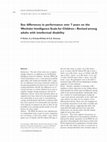
Intellectual Disability Research, 2004
Background: The aim of this study was to explore changes related to sex differences on the Wechsl... more Background: The aim of this study was to explore changes related to sex differences on the Wechsler Intelligence Scale for Children - Revised (WISC-R) subtest performance over a 7-year interval in middle-aged adults with intellectual disability (ID). Cognitive sex differences have been extensively studied in the general population, but there are few reports concerning individuals with ID. Sex differences are of current relevance to actively debated issues such as cognitive changes during menopause and risk for Alzheimer's disease. Given that hormonal effects on cognition have been observed in the general population, particularly in areas such as visuospatial processing, and individuals with Down's syndrome (DS) have been reported to be hormonally and reproductively atypical, we analysed our data to allow for the possibility of an aetiology-specific profile of sex differences for these adults.
Methods: The WISC-R subtests were administered in a longitudinal study, as part of a more comprehensive test battery, at least twice within 7 years. Participants were 18 females with ID without DS [age at first test time (time 1): mean = 40.5; IQ: mean = 59.3], 10 males with ID without DS (age at time 1: mean = 42.4; IQ: mean = 59.4), 21 females with DS (age at time 1: mean = 37.9; IQ: mean = 51.6), and 21 males with DS (age at time 1: mean = 40.3; IQ: mean = 54.3). All participants were in the mild to moderate range of ID and were displaying no changes suggestive of early dementia.
Results: Females, regardless of aetiology of ID, exhibited a robust superiority on the coding subtest, which parallels the widely reported difference among adults in the general population. Additionally, there was a decline in overall performance during the 7-year study interval, particularly on the verbal subscale subtests, but there was no evidence of sex-differentiated decline. There were also marginal sex by aetiology interactions on the object assembly and block design subtests, suggesting that males with unspecified ID might perform better than their female peers, but among adults with DS, females might do better than males.
Conclusions: This study supports the presence of cognitive sex differences in the population with ID as indicated by female superiority on the WISC-R coding subtest. Extending this observation to adults with ID has implications for explanations of female advantage on this task, which now have to account for its presence among individuals with a broader range of intellectual capabilities, more atypical developmental histories and more varied genotypes than previously considered. Trends towards sex by aetiology interactions on the two visuoconstructive subtests, while marginal, were sufficient to warrant continued consideration of the idea of a distinct profile of sex differences for adults with DS and to justify looking at the effects of sex separately within different aetiologies of ID.
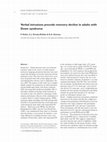
Journal of Intellectual Disability Research, 2006
Background Verbal intrusion errors are irrelevant responses made in the course of verbal memory r... more Background Verbal intrusion errors are irrelevant responses made in the course of verbal memory retrieval or language production that have been associated with disruption of executive functions and the prefrontal cortex. They have been observed to occur more frequently both with normal aging and with neurodegenerative diseases such as Alzheimer's disease (AD). The purpose of this study was to longitudinally examine the production of verbal intrusions among middle-aged adults with Down syndrome (DS) and unspecified intellectual disability (ID) to determine whether producing verbal intrusions at one point in time was related to subsequent verbal memory performance. Because of the combination of a relative deficit in verbal working memory (WM), premature aging, and higher risk of AD among adults with DS, it was predicted that they would make more verbal intrusions than adults with unspecified ID. Methods Word List recall (WLR), the Selective Reminding Test (SRT), and the Cued Recall Test (CRT), were administered three times at -month intervals during a -year period. In Analysis , aetiology differences in making intrusion errors were examined. Twenty-three adults with unspecified ID
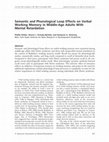
American Journal on Mental Retardation, 2004
Semantic and phonological loop effects on verbal working memory were examined among middle-age ad... more Semantic and phonological loop effects on verbal working memory were examined among middle-age adults with Down syndrome and those with unspecified mental retardation in the context of Baddeley's working memory model. Recall was poorer for phonologically similar, semantically similar, and long words compared to recall of dissimilar short words. Compared to their peers, participants with Down syndrome had poorer recall in all categories except phonologically similar words. Most interestingly, semantic similarity lowered recall scores only in participants with Down syndrome. This selective effect of semantics reflects an influence of long-term memory on working memory and points to the need for additional explanations outside phonological loop processes to completely account for the relative impairment of verbal working memory among individuals with Down syndrome.
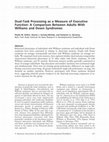
American Journal on Mental Retardation, 2008
Behavioral phenotypes of individuals with Williams syndrome and individuals with Down syndrome ha... more Behavioral phenotypes of individuals with Williams syndrome and individuals with Down syndrome have been contrasted in relation to short-term memory. People with Down syndrome are stronger visuospatially and those with Williams syndrome are stronger verbally. We examined short-term memory, then explored whether dual-task processing further characterized behavioral phenotypes in 53 older adults with Down syndrome, 10 with Williams syndrome, and 39 controls. Short-term memory profiles generally conformed to those of younger individuals. Pegs placement and number repetition were performed singly and simultaneously. There were no etiology group performance differences on single tasks. During concurrent processing, all groups maintained single-task performance on pegs, but declined on number repetition. However, participants with Down syndrome declined more, suggesting relatively greater weakness in the dual-task processing component of executive function for this group.
. American Journal on Intellectual and Developmental Disabilities, 2009
Auditory brainstem evoked responses (ABRs) were compared in 15 newborns with Down syndrome and 15... more Auditory brainstem evoked responses (ABRs) were compared in 15 newborns with Down syndrome and 15 sex-, age-, and weight-matched control newborns. Participants had normal ABRs based upon values specific to 32-to 42-weeks postconceptional age. Although Wave III and Wave V component latencies and the Wave I-III interpeak latency (IPL) were shorter in ABRs of infants with Down syndrome, the Wave III-V IPL was not, pointing to anomalies in the lower rather than upper brainstem auditory pathways. Shorter Down syndrome ABR latencies have been reported at many ages. Extending these findings to newborns suggests that the underlying basis for this develops prenatally. ABR patterns in infants with Down syndrome were similar to reports for intrauterine growth restricted newborns.
Developmental Neuropsychology, 2013
Neonatal intensive care unit (NICU) graduates have a higher incidence of attention problems inclu... more Neonatal intensive care unit (NICU) graduates have a higher incidence of attention problems including attention deficit hyperactivity disorder (ADHD). Thus, we examined the effect of risk factors (birth weight (BW), central nervous system (CNS) injury, gender, maternal education) on attention/inhibition during reaction time, continuous performance and Go/No-Go tasks at 42, 51, and 60 months (n = 271). Very low BW NICU graduates (<1,500 g) performed worse than typical BW ones (>2,500 g), displaying poorer target/non-target discrimination. Males responded faster than females, but made more false alarms and random responses. Despite short duration tasks, attention waned. Performance improved with age, but even at 60 months children had difficulty inhibiting random responding.

The Journal of Cognition and Development , 2013
Neonatal intensive-care unit (NICU) graduates, a group at risk for attention problems and attenti... more Neonatal intensive-care unit (NICU) graduates, a group at risk for attention problems and attention-deficit hyperactivity disorder, performed an intradimensional shift card sort at 34, 42, 51, and 60 months to assess executive function and to examine effects of individual risk factors. In the “silly” game, children sorted cards (airplanes and dogs) so they were not the same as targets. In the “same” game, they did the opposite. Performance on the “silly” game was poor, especially when it was presented first. Success in following “silly” game rules improved with age and was significantly linked to maternal education and birth weight for gestational age, a measure of intrauterine stress. Degree of central nervous system injury differentiated children who completed the task from children who did not, and it also affected the need to repeat instructions in the “same” game. These results confirm an increased likelihood of impairments in executive function during preschool years in NICU graduates.
Advances in reproductive and neonatal medicine have produced a much higher proportion of low birt... more Advances in reproductive and neonatal medicine have produced a much higher proportion of low birth weight (BW) and preterm infants who survive, often as a result of medical care delivered in a neonatal intensive-care unit (NICU). These infants suffer high rates of complications, such as chronic in-utero stress, respiratory distress, hypoxia, and central nervous system (CNS) injury, and they have an increased likelihood of developing problems related to attention, self-regulation, and executive function (EF), including attention-deficit hyperactivity disorder (ADHD; Bhutta,
Infant Behavior and Development, 2020
NICU infants are reported to have diminished social orientation and increased risk of sociocommun... more NICU infants are reported to have diminished social orientation and increased risk of sociocommunicative disorders. In this eye tracking study, we used a preference for upright compared to inverted faces as a gauge of social interest in high medical risk full-and pre-term NICU infants. We examined the effects of facial motion and audiovisual redundancy on face and eye/mouth
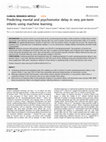
Pediatric Research, 2023
BACKGROUND: Very preterm infants are at elevated risk for neurodevelopmental delays. Earlier pred... more BACKGROUND: Very preterm infants are at elevated risk for neurodevelopmental delays. Earlier prediction of delays allows timelier intervention and improved outcomes. Machine learning (ML) was used to predict mental and psychomotor delay at 25 months. METHODS: We applied RandomForest classifier to data from 1109 very preterm infants recruited over 20 years. ML selected key predictors from 52 perinatal and 16 longitudinal variables (1-22 mo assessments). SHapley Additive exPlanations provided model interpretability. RESULTS: Balanced accuracy with perinatal variables was 62%/61% (mental/psychomotor). Top predictors of mental and psychomotor delay overlapped and included: birth year, days in hospital, antenatal MgSO 4, days intubated, birth weight, abnormal cranial ultrasound, gestational age, mom's age and education, and intrauterine growth restriction. Highest balanced accuracy was achieved with 19-month follow-up scores and perinatal variables (72%/73%). CONCLUSIONS: Combining perinatal and longitudinal data, ML modeling predicted 24 month mental/psychomotor delay in very preterm infants ½ year early, allowing intervention to start that much sooner. Modeling using only perinatal features fell short of clinical application. Birth year's importance reflected a linear decline in predicting delay as birth year became more recent.
Zenodo (CERN European Organization for Nuclear Research), Jul 1, 2023
Frontiers in integrative neuroscience, Jan 25, 2024
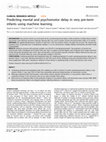
Pediatric Research
Background Very preterm infants are at elevated risk for neurodevelopmental delays. Earlier predi... more Background Very preterm infants are at elevated risk for neurodevelopmental delays. Earlier prediction of delays allows timelier intervention and improved outcomes. Machine learning (ML) was used to predict mental and psychomotor delay at 25 months. Methods We applied RandomForest classifier to data from 1109 very preterm infants recruited over 20 years. ML selected key predictors from 52 perinatal and 16 longitudinal variables (1–22 mo assessments). SHapley Additive exPlanations provided model interpretability. Results Balanced accuracy with perinatal variables was 62%/61% (mental/psychomotor). Top predictors of mental and psychomotor delay overlapped and included: birth year, days in hospital, antenatal MgSO4, days intubated, birth weight, abnormal cranial ultrasound, gestational age, mom’s age and education, and intrauterine growth restriction. Highest balanced accuracy was achieved with 19-month follow-up scores and perinatal variables (72%/73%). Conclusions Combining perinatal ...
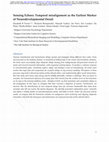
Neurodevelopmental disorders are on the rise worldwide, with diagnoses that detect derailment fro... more Neurodevelopmental disorders are on the rise worldwide, with diagnoses that detect derailment from typical milestones by 3-4.5 years of age. By then, the circuitry in the brain has already reached some level of maturation that inevitably takes neurodevelopment through a different course. There is a critical need then to develop analytical methods that detect problems much earlier and identify targets for treatment. We integrate data from multiple sources, including neonatal auditory brainstem responses (ABR), clinical criteria detecting autism years later in those neonates, and similar ABR information for young infants and children who also received a diagnosis of autism spectrum disorders, to produce the earliest known digital screening biomarker to flag neurodevelopmental derailment in neonates. This work also defines concrete targets for treatment and offers a new statistical approach to aid in guiding a personalized course of maturation in line with the highly nonlinear, acceler...

Infant Behavior and Development, 2020
NICU infants are reported to have diminished social orientation and increased risk of socio-commu... more NICU infants are reported to have diminished social orientation and increased risk of socio-communicative disorders. In this eye tracking study, we used a preference for upright compared to inverted faces as a gauge of social interest in high medical risk full- and pre-term NICU infants. We examined the effects of facial motion and audio-visual redundancy on face and eye/mouth preferences across the first year. Upright and inverted baby faces were simultaneously presented in a paired-preference paradigm with motion and synchronized vocalization varied. NICU risk factors including birth weight, sex, and degree of CNS injury were examined. Overall, infants preferred the more socially salient upright faces, making this the first report, to our knowledge, of an upright compared to inverted face preference among high medical risk NICU infants. Infants with abnormalities on cranial ultrasound displayed lower social interest, i.e. less of a preferential interest in upright faces, when viewing static faces. However, motion selectively increased their upright face looking time to a level equal that of infants in other CNS injury groups. We also observed an age-related sex effect suggesting higher risk in NICU males. Females increased their attention to the mouth in upright faces across the first year, especially between 7-10 months, but males did not. Although vocalization increased diffuse attention toward the screen, contrary to our predictions, there was no evidence that the audio-visual redundancy embodied in a vocalizing face focused additional attention on upright faces or mouths. This unexpected result may suggest a vulnerability in response to talking faces among NICU infants that could potentially affect later verbal and socio-communicative development.

Background: Early behavioral abnormalities more prevalent in Neonatal Intensive Care Unit (NICU) ... more Background: Early behavioral abnormalities more prevalent in Neonatal Intensive Care Unit (NICU) graduates later diagnosed with Autism Spectrum Disorder (ASD) have been reported by our group (Karmel et al., 2010). One of these was a visual preference for high rates of stimulation (8>3>1Hz.) when less aroused at four months post term age (PTA) (seen in our Arousal-Modulated-Attention (AMA) task); a preference found in newborns. These results suggested early problems with the attention/arousal system in ASD children; a system proposed to be modulated by brainstem function. Accordingly, we examined the extent to which another measure of early brainstem development, the auditory brainstem evoked response (ABR), contributed to the AMA preference in predicting the later emergence of ASD behaviors in NICU graduates. Objectives: To evaluate the contribution of both neonatal ABRs and 4 month PTA AMA preferences to later ASD behaviors in NICU graduates. Methods: As neonates, three CNS i...

Developmental Neuropsychology, 2011
Neonatal intensive care unit (NICU) graduates have a higher incidence of attention problems inclu... more Neonatal intensive care unit (NICU) graduates have a higher incidence of attention problems including attention deficit hyperactivity disorder (ADHD). Thus, we examined the effect of risk factors (birth weight (BW), central nervous system (CNS) injury, gender, maternal education) on attention/inhibition during reaction time, continuous performance and Go/No-Go tasks at 42, 51, and 60 months (n = 271). Very low BW NICU graduates (&amp;amp;amp;amp;amp;amp;amp;amp;amp;amp;amp;amp;amp;amp;amp;amp;amp;amp;amp;amp;amp;amp;amp;amp;amp;amp;amp;amp;amp;amp;amp;amp;amp;amp;amp;amp;amp;amp;lt;1,500 g) performed worse than typical BW ones (&amp;amp;amp;amp;amp;amp;amp;amp;amp;amp;amp;amp;amp;amp;amp;amp;amp;amp;amp;amp;amp;amp;amp;amp;amp;amp;amp;amp;amp;amp;amp;amp;amp;amp;amp;amp;amp;amp;gt;2,500 g), displaying poorer target/non-target discrimination. Males responded faster than females, but made more false alarms and random responses. Despite short duration tasks, attention waned. Performance improved with age, but even at 60 months children had difficulty inhibiting random responding.










Uploads
Papers by Phyllis Kittler
To analyze different approaches to the task, subjects were divided into an initial left visual field advantage and an initial right visual field advantage group. Over the course of the experiment subjects in the initial left visual field advantage group shifted from a left to a right visual field advantage, showing both a linear trend and a quadratic trend, while the initial right visual field advantage group showed only a quadratic trend. The results are consistent with observations in other novel stimuli situations which have demonstrated a shift in hemispheric advantage from right to left with increased competence and which have demonstrated individual differences in the pattern of shifting hemispheric advantage.
Methods: The WISC-R subtests were administered in a longitudinal study, as part of a more comprehensive test battery, at least twice within 7 years. Participants were 18 females with ID without DS [age at first test time (time 1): mean = 40.5; IQ: mean = 59.3], 10 males with ID without DS (age at time 1: mean = 42.4; IQ: mean = 59.4), 21 females with DS (age at time 1: mean = 37.9; IQ: mean = 51.6), and 21 males with DS (age at time 1: mean = 40.3; IQ: mean = 54.3). All participants were in the mild to moderate range of ID and were displaying no changes suggestive of early dementia.
Results: Females, regardless of aetiology of ID, exhibited a robust superiority on the coding subtest, which parallels the widely reported difference among adults in the general population. Additionally, there was a decline in overall performance during the 7-year study interval, particularly on the verbal subscale subtests, but there was no evidence of sex-differentiated decline. There were also marginal sex by aetiology interactions on the object assembly and block design subtests, suggesting that males with unspecified ID might perform better than their female peers, but among adults with DS, females might do better than males.
Conclusions: This study supports the presence of cognitive sex differences in the population with ID as indicated by female superiority on the WISC-R coding subtest. Extending this observation to adults with ID has implications for explanations of female advantage on this task, which now have to account for its presence among individuals with a broader range of intellectual capabilities, more atypical developmental histories and more varied genotypes than previously considered. Trends towards sex by aetiology interactions on the two visuoconstructive subtests, while marginal, were sufficient to warrant continued consideration of the idea of a distinct profile of sex differences for adults with DS and to justify looking at the effects of sex separately within different aetiologies of ID.
To analyze different approaches to the task, subjects were divided into an initial left visual field advantage and an initial right visual field advantage group. Over the course of the experiment subjects in the initial left visual field advantage group shifted from a left to a right visual field advantage, showing both a linear trend and a quadratic trend, while the initial right visual field advantage group showed only a quadratic trend. The results are consistent with observations in other novel stimuli situations which have demonstrated a shift in hemispheric advantage from right to left with increased competence and which have demonstrated individual differences in the pattern of shifting hemispheric advantage.
Methods: The WISC-R subtests were administered in a longitudinal study, as part of a more comprehensive test battery, at least twice within 7 years. Participants were 18 females with ID without DS [age at first test time (time 1): mean = 40.5; IQ: mean = 59.3], 10 males with ID without DS (age at time 1: mean = 42.4; IQ: mean = 59.4), 21 females with DS (age at time 1: mean = 37.9; IQ: mean = 51.6), and 21 males with DS (age at time 1: mean = 40.3; IQ: mean = 54.3). All participants were in the mild to moderate range of ID and were displaying no changes suggestive of early dementia.
Results: Females, regardless of aetiology of ID, exhibited a robust superiority on the coding subtest, which parallels the widely reported difference among adults in the general population. Additionally, there was a decline in overall performance during the 7-year study interval, particularly on the verbal subscale subtests, but there was no evidence of sex-differentiated decline. There were also marginal sex by aetiology interactions on the object assembly and block design subtests, suggesting that males with unspecified ID might perform better than their female peers, but among adults with DS, females might do better than males.
Conclusions: This study supports the presence of cognitive sex differences in the population with ID as indicated by female superiority on the WISC-R coding subtest. Extending this observation to adults with ID has implications for explanations of female advantage on this task, which now have to account for its presence among individuals with a broader range of intellectual capabilities, more atypical developmental histories and more varied genotypes than previously considered. Trends towards sex by aetiology interactions on the two visuoconstructive subtests, while marginal, were sufficient to warrant continued consideration of the idea of a distinct profile of sex differences for adults with DS and to justify looking at the effects of sex separately within different aetiologies of ID.